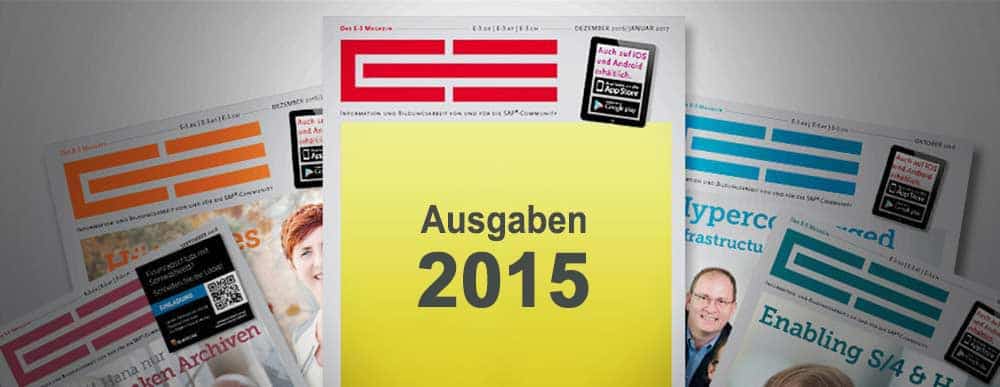Branch in the center of logistics


Over 1,700 retail outlets, which are supplied every other day, a maximum throughput of 800,000 delivery items per day on a logistics area of 80,000 square meters and 1.5 million webshop orders per year - the logistical requirements of Ernsting's Family are enormous in terms of quantity alone.
In addition, there are qualitative expectations in terms of flexibility, efficiency, performance and user-friendliness. SAP EWM provides the textile company with a warehouse management solution that meets all these requirements and fits perfectly into the existing SAP landscape.
The logistical processes in the distribution centers, the regional center and within the transport network are geared towards the requirements of the stores.
These combine a large number of different items in a small sales area. However, only a small number of each item variant is available on site.
A distinction must also be made between push and pull products. The company launches an average of 40 new styles every day (push), while sales and, above all, NOS (never out of stock) items have to be replenished at short notice (pull).
Ernsting's Family meets these requirements by delivering to every store every other day.
Without extensive returns handling
In addition to the closely timed store deliveries, there is also the processing of the online store, which has been in operation since 2003. Ernsting's Family currently receives 1.5 million orders a year, which are either delivered directly to the end customer by a CEP service provider or to the nearest store.
Returns can also be handed in directly at the store using this uncomplicated method. The clothing retailer is pursuing a multi-channel strategy as it should be - the customer chooses the most uncomplicated way and Ernsting's Family can focus on smooth logistical processing.
This is because Ernsting's Family largely avoids extensive returns handling, which is virtually unavoidable in the e-commerce market: The majority of customers bring their returns directly to the store, where they are immediately booked with the local stock.
Standardized SAP landscape
The SAP EWM warehouse management system has been monitoring the complex and high-performance processes required for this since the beginning of 2013. The decision for a new IT control system had already been made in 2011.
For Ernsting's Family, the limits of the existing system became apparent for the first time, and the need for an integrated SAP landscape grew - until then, logistics was the only area of the company not yet controlled by SAP.
One of the aims of the software changeover was to create an integrated system landscape in all areas of the company. Coupled with SAP EWM as the new IT system, performance was further increased and growing throughput figures were achieved.
The topic of multi-channel could not be neglected either. With SAP EWM, a system was found that could optimally handle the various requirements of the different sales channels and process store and end customer deliveries in parallel.
The logistics software specialist Inconso carried out the design and implementation in a three-stage project.
Implementation of the system changeover began in April 2012. The initial focus was on the Klieken site. In the first stage, the automated carton warehouse was connected to SAP EWM.
Three or four cartons per tray are stored in four aisles. This is connected to a carton conveyor technology pre-zone with six workstations.
Incoming goods and replenishment for NOS goods were also taken over at both locations. These processes went live in January 2013.
In July of the same year, the remaining processes in Klieken followed in the second stage. Incoming goods and labeling for fashion goods as well as all picking processes for fashion goods, subsequent deliveries and NOS goods for around 850 stores were converted.
The automatic, partially double-deep pallet warehouse has also been controlled by SAP EWM since then. Pallets, roll containers and empties are stored here. Roll containers and slave pallets are loaded and unloaded either manually or semi-automatically.
Goods receipt and labeling decoupled
In both Klieken and Lette, the incoming goods process is handled separately from the labeling process. This means that the fashion goods received are initially stored in original cartons on pallets in the high-bay warehouse without recording the number of items.
However, the quality check is already carried out at this stage. Only then are the goods prepared for picking, they are separated and repacked onto roll containers, the actual quantity is recorded and then put back into storage.
This decoupling of incoming goods and labeling has a positive effect on the process efficiency of logistics. As goods are rarely delivered on the date they are supposed to be delivered, Ernsting's Family can avoid idle times in the warehouse areas. In addition, goods can be rescheduled flexibly and at short notice.
In the third stage of the project, the Lette site was also put into operation with SAP EWM in January 2014, similar to the Klieken site. In addition, goods receipt and replenishment for the direct customer business were integrated via the online store and the automated pallet warehouse was connected.
Here, up to 2,500 pallets or roll containers are stored and retrieved daily across eleven aisles and 22,000 pallet spaces. In contrast to the Klieken site, roll containers and slave pallets can be automatically married and unmarried here.
Interaction of SAP ERP and EWM
The outgoing goods department not only has to prepare the various delivery processes to the store, but also handle stock transfers between locations, staff sales and returns to suppliers.
In store delivery, a distinction is made between the initial distribution of fashion (push delivery), the automatic subsequent delivery of fashion and NOS goods, the delivery of consumables, spontaneous deliveries and transfers between stores.
SAP ERP and EWM act as independent systems. Allocation tables are first created in ERP, in which the quantities per store are defined and outbound deliveries including delivery date are generated. EWM then combines these individual allocation tables into groups and creates a suggested location on the picking area for a delivery date.
Outsourcing of replenishment in three waves
The picking documents are printed in three waves at the same time as the replenishment is retrieved. In the first wave, one roll container per article variant is placed on the picking area. The second wave is determined by the requirements for the stores on the first tour. Rounded up to full roll containers, these are also arranged in the picking area for each article variant. The third wave contains the articles for the second tour. The printed document is then used for picking. The outgoing goods posting takes place in the background and after the actual dispatch or a maximum of one day before the official delivery date.
With automatic subsequent delivery, the ERP system creates the necessary outbound deliveries depending on the sales of the stores (pull principle). For each message to SAP EWM, only stores on the tour that can be picked the following day are taken into account. SAP EWM then determines the picking sequence and calculates the necessary round trips for the first 50 stores. Depending on the volume required for the stores, picking is then carried out using multi-order picking or picking for each store using MDE.





